Published in The Guardian on Wednesday 9 October 2019
The rise and rise of Bangladesh – but is life getting any better?
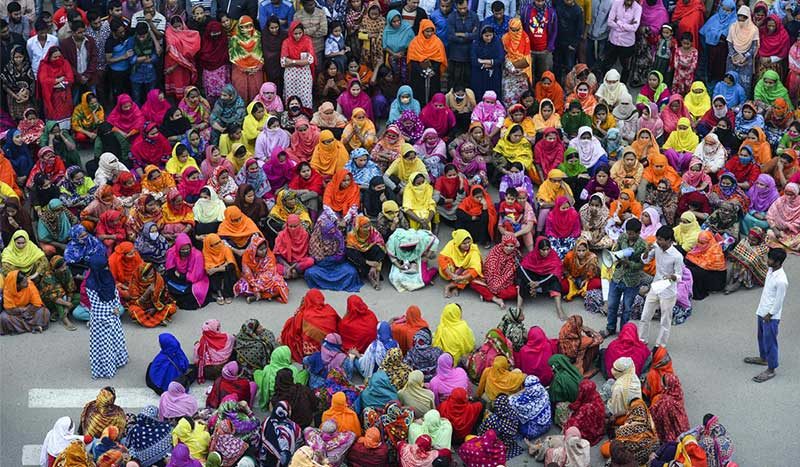
The country has undergone an economic miracle in recent years, albeit at huge cost to its garment workers. But things are finally starting to improve for them
Tasnia Akter has come home. It’s a public holiday in Bangladesh, the one time of year the 25-year-old can leave the mayhem of the city behind and see her family: her mother, her aunt. And her daughter.
“There she is!” Her little girl is standing in front of the two-bedroom tin hut in a remote village 200km (125 miles) north of Chittagong, south-east Bangladesh. Mother and daughter embrace.
If she could, the young seamstress would still live here. The air is fresher, there is more space, and some of her friends still live in the village. There’s just one problem: “There isn’t any work.” Agriculture has ceased to be a feasible source of income. Money doesn’t grow on trees – it is spun in the textile looms of the city.
And so this family copes as best it can, the older women raising the child while Tasnia works six-day weeks, sewing T-shirts and jeans for global consumers, for about 8,400 taka (£80) a month.
These three generations are a neat microcosm of an entire nation. The older women, who grew up in the years after independence in 1971, worked in unpaid labour, trying to survive in the grinding poverty for which the country became renowned in the 1970s.
The young girl, a 21st-century child, schooled and spirited, will in all probability enjoy better prospects. And in the middle, Tasnia Akter, from the “factory generation”, one of approximately 4.5 million textile workers who have transformed the fortunes and reputation of Bangladesh.
The crucial question is this: is Akter a glorious paragon of the “rise and rise” of Bangladesh, with its 50-year journey to becoming a middle-income nation powered by hard-working women? Or is she a sickening example of an exploited labourer who ruins her health for companies making high margins and consumers who buy cheap jeans?
The answer: perhaps a bit of both.
“Sure, Tasnia suffers a lot, she has to support her family – but I had to suffer much more,” says her aunt, Honufa Begum. After her husband died, Begum worked as a maid in Chittagong. “Just provide food and lodging for me and my daughter,” she recalls asking the family. They did. But they did not pay her. Begum did not complain.
“I am uneducated,” Akter explains, sitting on a bed in her aunt’s house under a fan. “In the city I could work as a maid. But I don’t want to be a slave. I don’t want to always be on my toes, waiting for orders. At least when I come home in the evening from the factory, I am done for the day.”
Changed fortunes
When the history is written of how much of humanity was lifted out of poverty in the decades after 1980, Bangladesh will provide one of the biggest chapters. GDP has soared vertiginously since 1980.
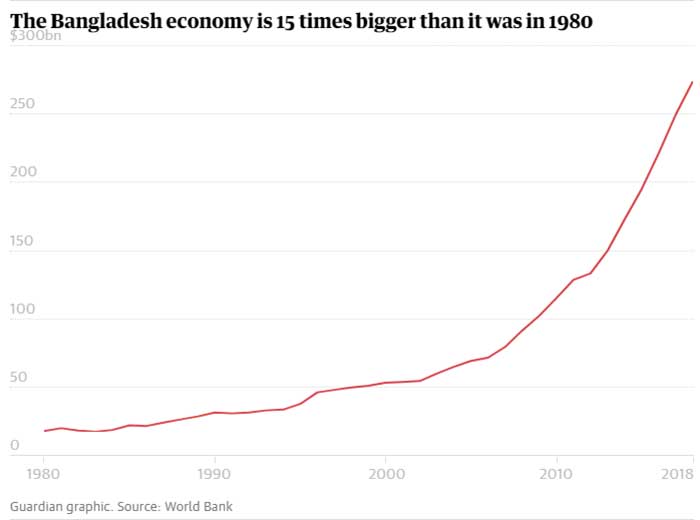
The number of people living below the poverty line has fallen from more than 44% in 1991 to less than 13%. Numbers for neonatal and maternal mortality have dwindled. Family sizes have fallen.

People now live on average one-third longer than they used to 40 years ago – a gain in longevity that is practically without rival anywhere in the world.
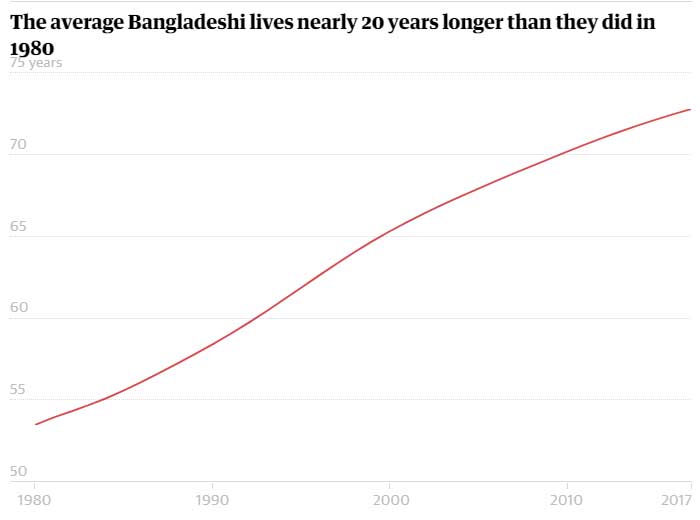
But it has not come without tragedy, toil and exploitation. Six years ago, the Rana Plaza factory collapsed in Dhaka, killing more than 1,100 people, injuring more than 2,300. Rana Plaza became synonymous with textile workers’ atrocious working conditions; for the blood, sweat and sacrifice so easily overlooked by western consumers hunting bargain T-shirts on the high street. Bangladeshi workers are still among the lowest-paid in the world.
Over the years, however, activists, workers and researchers have fought for at least some change in the garment industry. The minimum wage has doubled. Safety improvements have been made. Many workers are able to put a little aside to ensure that their children get a proper education.
And for Akter and the millions of other women who make up around 80% of the textile workforce, the industry represents a possibility to earn money. They can attain at least some economic freedom in a society where women typically are housewives; where the only option in the countryside is to marry.
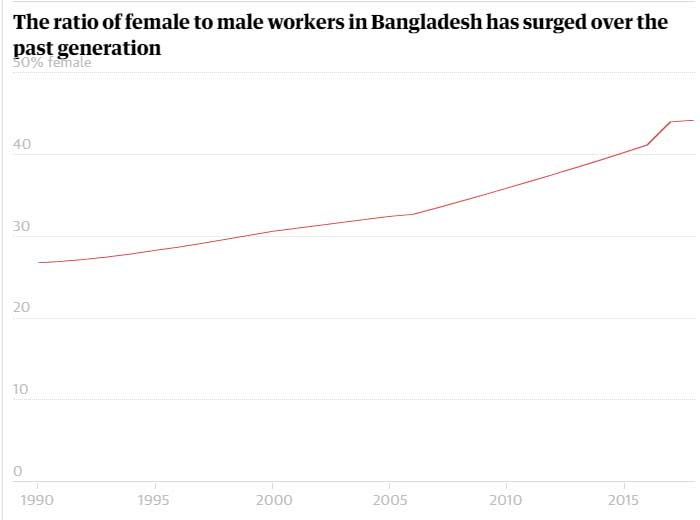
The vast industry generates myriad sub-industries too. The market along the dusty main road in Chittagong is usually bustling with people. Opposite the Clifton garments factory, Jallal Uddin, 38, is selling cake, bananas and tea to the workers on their way home. The father of two has had his stall for eight years now. He is proud of not having accumulated any debt. His formula is simple: the more garment workers there are, the more business for him.
Tasnia Akter has been working for her factory for the past four years. The small premises is owned by one of the country’s big manufacturers: there are more than 30,000 employees, with brand customers such as WalMart and H&M. For Akter, working in the factory means progress: it is a means of paying the debts of her family, to support her seven-year-old daughter, and to earn a living after her husband left her – a fate that many garment workers share.
“I don’t really have a choice,” she says. She sends around 2,000 taka home every month, as well as the occasional windfall: a rice cooker is stored in her parents’ cupboard; the company awarded it to her for not missing any days and for working quickly.
But if she can’t save anything for herself, is she really getting on? Is progressing from slave-like working conditions to meagre salaries really enough? Or is the country’s sweatshop image still accurate today?
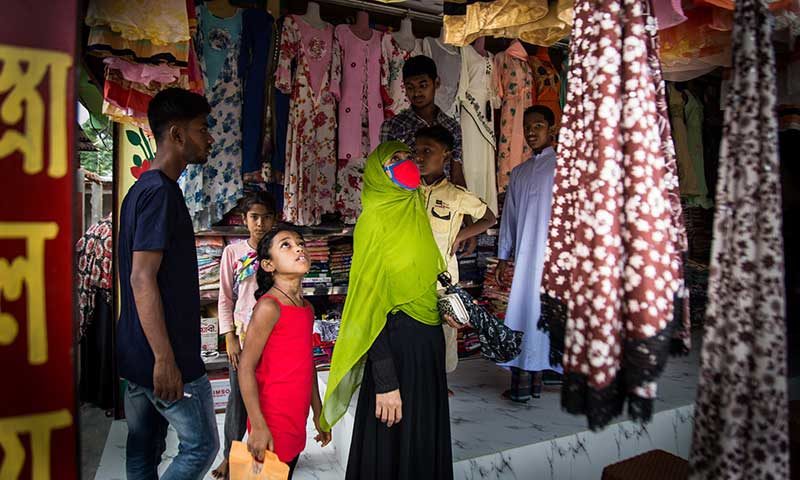
Khondaker Golam Moazzem, research director at the Centre for Policy Dialogue (CPD), a thinktank in Dhaka, shakes his head. “Not at all.” The economist believes that – at least in a broader sense – the textile industry has lifted millions out of poverty. In the 1980s, workers lived in shacks and toiled in factories with no toilets or safe drinking water. Now even a cursory look at their lunch boxes will show they are eating better than in the past, he says.
But he adds that many workers are malnourished and some still sleep on the floor. “Most workers can’t save anything for their post-work years.” Nevertheless, there are small indications that the quality of life is improving. “Workers like to spend the last penny for the betterment of the family: some send their children to private kindergarten, or to private tutors.”
It was the Rana Plaza disaster that arguably triggered the biggest safety improvements. Following a broad deal between unions and more than 200 garment companies such as Primark and H&M, more than 1,600 factories were inspected and hazards identified and dealt with. Factory owners invested in fire doors, sprinkler systems and electrical upgrades. Some tore down factories and built them anew to keep their business going. A general manager of the company where Tasnia Akter works says the new rules of business are simple: “No compliance, no contracts.”
“If you compare pre-Rana Plaza and post-Rana Plaza, the one thing that really has changed is safety,” says Kalpona Akter (no relation to Tasnia), a labour activist and executive director of the Bangladesh Centre for Worker Solidarity (BCWS). Between 2005 and 2012, more than 500 workers died in textile factories. After 2014, the annual number of fatalities has remained “well under 30”, according to the Stern Centre for Business and Human Rights at New York University .
“Workers are now more aware of their rights,” says Kalpona Akter. When she founded BCWS in 2000, few workers knew they had any rights at all.

“Now workers perhaps won’t die in the factory – but they will nevertheless slowly die of malnourishment,” Hasan Maruf Rumi says. The activist and politician explains how it is impossible to feed a family on the new minimum wage of 8,000 taka.
While the minimum wage has indeed been doubled, it is still only half of what the unions had suggested – and far from a living wage.
A study by CPD found that the overall cost of living for garment workers had increased by 86% between 2013 and 2018, with food costs up 57%. Last December the influential manufacturers’ association BGMEA made it clear that owners would close factories if the minimum wage increased further. It called on brands to increase their prices as a result. Nothing happened.
When asked how much she thinks she deserves, Tasnia Akter says: 10,000 taka, around £96.
In Chittagong, many workers live near the factories. The streets, turned muddy by the rain, are lined with corner shops, barbers and vegetable sellers. Nadira Begum, a 26-year-old sewing operator, shares a room with her three-year-old daughter in a compound with other families. Her husband shows up from time to time; he has another wife as well.
“As soon as there is a raise, everything gets more expensive,” she says. She already pays around 3,000 taka per month for the room. While Begum earns about nine times as much as her mother, she is unsure whether her purchasing power has gone up much. She does have amenities such as a fan and a fridge. She joined the union after it helped her when she was about to be fired for being pregnant, she says. Now she has lost her job. Begum believes it is primarily because she is a union member. But she doesn’t seem too fazed. One thing that has changed is her self-assurance, the pride in her abilities: “I am not worried. I am a skilled worker; I will just go and get another job.”
This article is part of a series on possible solutions to some of the world’s most stubborn problems. What else should we cover? Email us at theupside@theguardian.com



